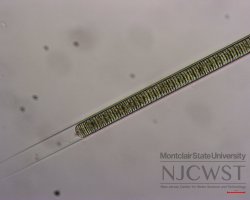Taxonomy
- Order
- Oscillatoriales
- Family
- Oscillatoriaceae
- Genus
- Limnoraphis
Examples of Limnoraphis
Morphology
Straight to slightly flexuous filaments; mostly solitary; rarely in small and irregular aggregations; up to 20 μm wide, and usually wider than 6 μm. Sheaths usually present; firm, colorless, fairly thin, with one trichome per sheath. Trichomes cylindrical; unconstricted to slightly constricted at crosswalls; not narrowed at the ends. Cells always shorter than wide; short and discoid (flattened, coin-like shape). Apical cells widely rounded, sometimes with a slightly thickened outer wall; without a calyptra. Aerotopes are present, but develop irregularly in segments along the length of the trichome; Komárek et al (2013) describe these aerotope-filled portions as looking like darker-colored segments scattered along the length of the trichome. Blooms are yellowish-brown in color due to the cells’ relatively high concentration of carotenoids.
This genus was separated relatively recently from Lyngbya; the presence of aerotopes and planktic nature of Limnoraphis distinguish it from Lyngbya (Komárek et al 2013).
Ecology
Planktic or metaphytic in lakes, reservoirs. In the United States, reported from northern lakes. Limnoraphis robusta is known to form water blooms in lakes near the western coast of the Americas (from California to Peru).
References
- Johansen, J. R., & Komárek, J. (2015). Filamentous Cyanobacteria. In J. D. Wehr, R. G. Sheath, & J. P. Kociolek (Eds.), Freshwater Algae of North America: Ecology and Classification (2nd ed., pp. 162-177). Waltham, MA: Elsevier.
- Komárek, J., Zapomelova, E., Smarda, J., Kopecky, J., Rejmankova, E., Woodhouse, J., Neilan, B.A., & Komarkova, J. (2013). Polyphasic evaluation of Limnoraphis robusta, a water–bloom forming cyanobacterium from Lake Atitlán, Guatemala, with a description of Limnoraphis gen. nov. Fottea, Olomouc, 13(1): 39-52.

